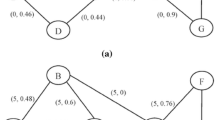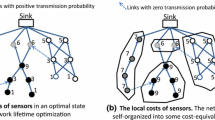Abstract
Since the energy constraint is a fundamental issue for wireless sensor networks, the expectation of network lifetimes becomes a critical performance index. In actual applications, the data traffic on an available routing path could fluctuate from time to time, so there is a compelling need for a robust routing strategy to make the links robust enough when the link outage happens. In the paper, we jointly integrate the maximization of network lifetime and the designing of robust routing strategy into consideration, by which both two subproblems are modeled in a framework of cross-layer nonlinear optimization. By using the popular anti-risk methods popularly used in financial mathematics, our proposed cross-layer optimization problem can be transformed to a convex expression, while its uncertain probabilistic constraints are further changed to a specific solvable expression. Inspired by the particle swarm intelligence in recent development of evolutionary computation, a penalty function based method is introduced and applied in the optimal solution searching process. The effectiveness of our robust routing design is validated by the extensive simulation results, and the quantitative interactions among different neighboring links are also analysed in a typical network topology.









Similar content being viewed by others
References
Hou, Y. T., & Shi, Y. (2007). Variable bit rate flow routing in wireless sensor networks. IEEE Transactions on Wireless Communications, 6(6), 2140–2148.
Yang, B., Feng, G., Long, C., & Guan, X. (2006). Maximum lifetime rate control and random access in multi-hop wireless networks. Computer Communications, 29(18), 3844–3855.
Boulfekhar, S., & Benmohammed, M. (2013). A novel energy efficient and lifetime maximization routing protocol in wireless sensor networks. Wireless Personal Communications, 72(2), 1333–1349.
Shi, Y., Hou, Y. T., & Shereli, H. D. (2008). Cross-layer optimization for MIMO-based wireless ad hoc networks: Routing, power allocation, and bandwidth allocation. IEEE Journal on Selected Areas in Communications, 26(6), 913–926.
Ding, L., Melodia, T., Batalama, S. N., Matyjas, J. D., & Medley, M. J. (2010). Cross-layer routing and dynamic spectrum allocation in cognitive radio ad hoc networks. IEEE Transactions on Vehicular Technology, 59(4), 1969–1979.
Li, M., Jing, Y., & Li, C. (2013). A robust and efficient cross-layer optimal design in wireless sensor networks. Wireless Personal Communications, 72(4), 1889–1902.
Huang, X., Zhai, H., & Fang, Y. (2008). Robust cooperative routing protocol in mobile wireless sensor networks. IEEE Transactions on Wireless Communications, 7(12), 5278–5285.
Pandana, C., Arraycomm, S., & Liu, K. J. R. (2008). Robust connectivity-aware energy-efficient routing for wireless sensor networks. IEEE Transactions on Wireless Communications, 7(10), 3904–3916.
Yang, M., Wang, J., Gao, Z., Jiang, Y., & Yoohwan, K. (2005). Coordinated robust routing by dual cluster heads in layered wireless sensor networks. In Proceedings of the 8th international symposium on parallel architectures, algorithms and networks (ISPAN'05) (pp. 454–461). Las Vegas, Nevada.
Lima, C., & de Abreu, G. T. F. (2008). Clusterization for robust geographic routing in wireless sensor networks. In Proceedings of IEEE wireless communications and networking conference (IEEE WCNC’2008) (pp. 2385–2390). Las Vegas, Nevada.
Song, Y., Zhang, C., & Fang, Y. G. (2009). Harnessing traffic uncertainties in wireless mesh networks—A stochastic optimization approach. ACM Mobile Networks and Applications (MONET), 14(2), 124–133.
Applegate, D., & Cohen, E. (2003). Making intra-domain routing robust to changing and uncertain traffic demands: Understanding fundamental tradeoffs. In Proceedings of ACM conference of the special interest group on data communication’03 (SIGCOMM'03) (pp. 313–324). Karlsruhe, Germany.
Li, Y. X., Harms, J., & Holte, R. (2006). Optimal traffic-oblivious energy-aware routing for multihop wireless networks. In Proceedings of 25th IEEE international conference on computer communications (INFOCOM'06) (pp. 1–12). Barcelona, Spain.
Wang, H., Agoulmine, N., Ma, M., & Jin, Y. (2010). Network lifetime optimization in wireless sensor networks. IEEE Journal on Selected Areas in Communications, 28(7), 1127–1137.
Chen, L., Low, S. H., Chiang, M., & Doyle, J. C. (2006). Cross-layer congestion control, routing and scheduling design in ad hoc wireless networks. In Proceedings of 25th IEEE international conference on computer communications (INFOCOM'06) (pp. 1–13). Barcelona, Spain.
Kodialam, M., & Nandagopal, T. (2005). Characterizing achievable rates in multi-hop wireless mesh networks with orthogonal channels. IEEE/ACM Transactions on Networking, 13(4), 868–880.
Xue, L., Yang, B., Zhao, J., Liu, Z., & Guan, X. (2013). Joint resource reconfiguration and robust routing for cognitive radio networks: A robust optimization approach. Wireless Communications and Mobile Computing, 13(18), 2165–2184.
Sohrabi, K., Gao, J., Ailawadhi, V., & Pottie, G. (2000). Protocols for selforganizing of a wireless sensor network. IEEE Personal Communications, 7, 16–27.
Yang, B., Shen, Y., Johansson, M., Chen, C., & Guan, X. (2013). Opportunistic multichannal access with decentralized channel state information. Wireless Communications and Mobile Computing. doi:10.1002/wcm.2348.
Madan, R., & Lall, S. (2006). Distributed algorithms for maximum lifetime routing in wireless sensor networks. IEEE Transactions on Wireless Communications, 5(8), 2185–2193.
Jiang, C., Shi, Y., Hou, Y. T., Lou, W., & Sherali, H. D. (2013). Throughput maximization for multi-hop wireless networks with network-wide energy constraint. IEEE Transactions on Wireless Communications, 12(3), 1255–1267.
Yu, Y. L., Li, Y., Schuurmans, D., & Szepesvari, C. (2009). A general projection property for distribution families. In Proceedings of 23rd annual conference on neural information processing systems (NIPS'09) (pp. 2232–2240). Vancouver, Canada.
Zhu, S., & Fukushima, M. (2009). Worst-case conditional value-at-risk with application to robust portfolio management. Operations Research, 57(5), 1155–1168.
Song, Y., Zhang, C., & Fang, Y. (2009). Harnessing traffic uncertainties in wireless mesh networks—A stochastic optimization approach. ACM Mobile Networks and Applications, 14(2), 124–133.
Fan, R., Li, Y., & Jiang, H. (2012). Power-efficient robust routing and resource allocation in wireless mesh networks. In Proceedings of IEEE international conference on communications (ICC'2012) (pp. 450–454). Ottawa, Canada.
Daneshyari, M., & Yen, G. G. (2012). Constrained multiple-swarm particle swarm optimization within a cultural framework. IEEE Transactions on System, Man, and Cybernetics-Part A: Systems and Humans, 42(2), 475–490.
Kennedy, J., & Eberhart, R. (1995). Particle swarm optimization. In Proceedings of IEEE international conference on neural networks (INN'1995) (pp. 1924–1948). Perth, Australia.
Qua, Z., & Yang, Q. (2013). Improved particle swarm optimization for constrained optimization. In Proceedings of 2013 international conference on information technology and applications (ITA'2013) (pp. 244–247). Chengdu, China.
Valle, Y., Venayagamoorthy, G. K., Mohagheghi, S., Hernandez, J. C., & Harley, R. G. (2008). Particle swarm optimization: Basic concepts, variants and applications in power systems. IEEE Transactions on Evolutionary Computation, 12, 171–195.
Sun, X., Li, Z., Zhao, C., & Zhou, Z. (2012). Cognitive UWB pulse waveform design based on particle swarm optimization. Ad Hoc & Sensor Wireless Networks, 16(1–3), 215–228.
Elsayed, S. M., Sarker, R. A., & Mezura-Montes, E. (2013). Particle swarm optimizer for constrained optimization. In Proceedings of 2013 IEEE congress on evolutionary computation (CEC'2013) (pp. 2703–2711). Cancun, Mexico.
Perez, R. E., & Behdinan, K. (2007). Particle swarm approach for structural design optimization. Computers and Structures, 85, 1579–1588.
Acknowledgements
This work was supported by National Natural Science Foundation of China (61304131, 61402147), the Grant of China Scholarship Council (201608130174), the Natural Science Foundation of Hebei Province (F2016402054, F2014402075), the Scientific Research Plan Projects of Hebei Education Department (BJ2014019, ZD2015087, QN2015046), the Research Program of Talent Cultivation Project in Hebei Province (A2016002023).
Author information
Authors and Affiliations
Corresponding author
Rights and permissions
About this article
Cite this article
Xue, L., Wang, Y., Li, Z. et al. Robust Routing Design with Consideration of Lifetime Maximization for Wireless Sensor Networks in a Framework of Anti-risk Strategy with the Improved Constrained Particle Swarm Optimization Approach. Wireless Pers Commun 94, 527–558 (2017). https://doi.org/10.1007/s11277-016-3453-z
Published:
Issue Date:
DOI: https://doi.org/10.1007/s11277-016-3453-z




